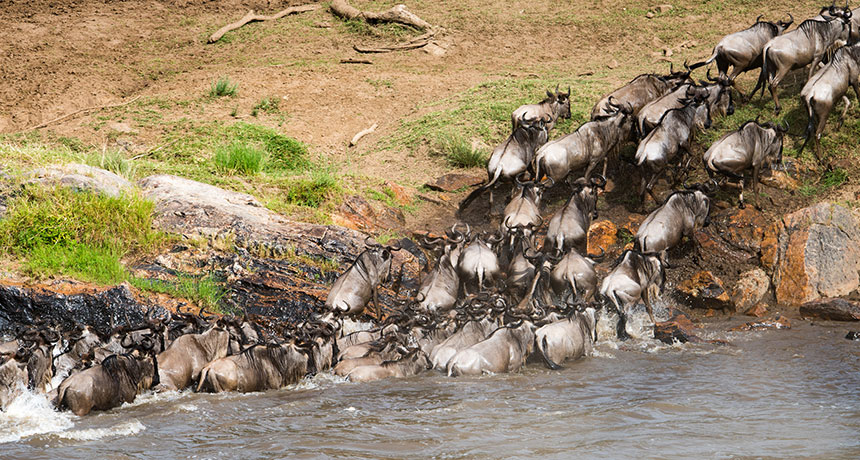Drowned wildebeests can feed a river ecosystem for years

More than a million wildebeests migrate each year from Tanzania to Kenya and back again, following the rains and abundant grass that springs up afterward. Their path takes them across the Mara River, and some of the crossings are so dangerous that hundreds or thousands of wildebeests drown as they try to traverse the waterway.
Those animals provide a brief, free buffet for crocodiles and vultures. And, a new study finds, they’re feeding an aquatic ecosystem for years.
Ecologist Amanda Subalusky of the Cary Institute of Ecosystem Studies in Millbrook, N.Y., had been studying water quality in the Mara River when she and her colleagues noticed something odd. Commonly used indicators of water quality, such as dissolved oxygen and turbidity, were sometimes poorest where the river flowed through a protected area. They quickly realized that it was because of the animals that flourished there. Hippos, which eat grass at night and defecate in the water during the day, were one contributor. And dead wildebeests were another.
“Wildebeest are especially good at following the rains, and they’re willing to cross barriers to follow it,” says Subalusky. The animals tend to cross at the same spots year after year, and some are more dangerous than others. “Once they’ve started using a site, they continue, even if it’s bad,” she notes. And on average, more than 6,000 wildebeests drown each year. (That may sound like a lot, but it’s only about 0.5 percent of the herd.) Their carcasses add the equivalent of the mass of 10 blue whales into the river annually.
Subalusky and her colleagues set out to see how all that meat and bone affected the river ecosystem. When they heard about drownings, they would go to the river to count carcasses. They retrieved dead wildebeests from the water to test what happened to the various parts over time. And they measured nutrients up and downstream from river crossings to see what the wildebeest carcasses added to the water.
“There are some interesting challenges working in this system,” Subalusky says. For instance, in one experiment, she and her colleagues put pieces of wildebeest carcass into mesh bags that went into the river. The plan was that they would retrieve the bags over time and see how quickly or slowly the pieces decomposed. “We spent a couple of days putting the whole thing together and we came back the next day to collect our first set of samples,” she recalls. “At least half the bags with wildebeest meat were just gone. Crocodiles and Nile monitors had plucked them off the chain.”
The researchers determined that the wildebeests’ soft tissue decomposes in about two to 10 weeks. This provides a pulse of nutrients — carbon, nitrogen and phosphorus — to the aquatic food web as well as the nearby terrestrial system. Subalusky and her colleagues are still working out the succession of scavengers that feast on the wildebeests, but vultures, marabou storks, egg-laying bugs and things that eat bugs are all on the list.
Once the soft tissue is gone, the bones remain, sometimes piling up in bends in the river or other spots downstream. “They take years to decompose,” Subalusky says, slowly leaching out most of the phosphorus that had been in the animal. The bones can also become covered in a biofilm of algae, fungi and bacteria that provides food for fish.
What initially looks like a short-lived event actually provides resources for seven years or more, Subalusky and her colleagues report June 19 in the Proceedings of the National Academy of Sciences.
The wildebeest migration is the largest terrestrial migration on the planet, and others of its kind have largely disappeared as humans have killed off animals or cut off their migration routes.
Only a few hundred years ago, for instance, millions of bison roamed the western United States. There are accounts in which thousands of bison drowned in rivers, similar to what happens with wildebeests. Those rivers may have fundamentally changed after bison were nearly wiped out, Subalusky and her colleagues contend.
We’ll never know if that was the case, but there are still some places where scientists may be able to study the effects of mass drownings on rivers. A large herd of caribou reportedly drowned in Canada in the 1980s, and there are still some huge migrations of animals, such as reindeer. Like the wildebeests, these animals might be feeding an underwater food web that no one has ever noticed.